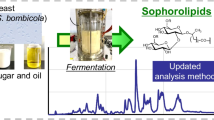Abstract
The physical properties and chemical structure of a new biosurfactant (licheniformin) produced by Bacillus licheniformis MS3 were investigated. The purified biosurfactant was identified as a lipopeptide with amino acid sequence of Gly, Ala, Val, Asp, Ser, Gly, Tyr and a lactone linkage between the carboxyl group of Aspargine and hydroxyl group of Tyrosine residue. The fatty acid moiety was attached to N-terminal amino acid residue through an amide bond. The purified licheniformin could lower the surface tension of water from 72 to 38 mN/m at concentrations higher than 15 μg/mL and its relative emulsion volume (EV%) was equal to 36%. It also showed stable surface activity over a wide range of temperature (45–85°C) and pH (3–11).







Similar content being viewed by others
References
Ahimou F, Jacques Ph, Deleu M (2000) Surfactin and iturin A, effects on Bacillus subtilis surface hydrophobicity. Enzyme Microbial Technol 27:749–754
Angelova B, Schmauder HP (1999) Lipophilic compounds in biotechnology-interactions with cells and technological problems. J Biotechnol 67:13
Batista SB, Mounteer AH, Amorim FR, To′ tola MR (2006) Isolation and characterization of biosurfactant/bioemulsifier-producing bacteria from petroleum contaminated sites. Biores Technol 97:868–875
Biria D, Roostaazad R, Daroune E, Izadi H (2007) Analysis of MEOR efficiency to increase recovery in an Iranian reservoir. Scientia Iranica 14:161–168
Biria D, Maghsoudi E, Roostaazad R (2008) Application of extractive electroflotationin surfactant recovery from oil in water emulsions. 7th world conference of surfactants (CESIO 2008) Paris, France
Das M, Das SK, Mukherjee RK (1998) Surface active properties of the culture filtrates of a Micrococcus species grown on n-alkenes and sugars. Biores Technol 63:231–235
Fiechter A (1992) Biosurfactants: moving towards industrial application. Trends Biotechnol 10:208–217
Gutierrez JR, Erickson LE (1977) Hydrocarbon uptake in hydrocarbon fermentations. Biotechnol Bioeng 19:1331–1349
Hathout Y, Ho YP, Ryzhov V, Demirev P, Fenselau C (2000) Kurstakins: a new class of lipopeptides isolated from Bacillus thuringiensis. J Nat Prod 63:1492–1496
Jenny K, Kappeli O, Fiechter A (1991) Biosurfactants from Bacillus licheniformis: structural analysis and characterization. Appl Microbiol Biotechnol 36:5–13
Kochhar S, Mouratou B, Christen P (2001) Amino acid analysis by high-performance liquid chromatography after derivatization with 1-fluoro-2, 4-dinitrophenyl-5-l-alanine amide. In: Cooper C, Packer N, Williams K (eds) Methods in molecular biology, vol. 159: amino acid analysis protocols. Humana Press, Totowa
Lin SC, Minton MA, Sharma MM, Georgiou G (1994) Structural and immunological characterization of a biosurfactant produced by Bacillus licheniformis JF-2. Appl Environ Microbiol 60:31–38
Lowry OH, Rosebrough NJ, Farr AL, Randall RJ (1951) Protein measurement with the folin phenol reagent. J Biol Chem 193:265–275
Matsuyama T, Kaneda K, Nakagawa Y, Isa K, Hara-Hotta H, Yano I (1992) A novel extracellular cyclic lipopeptide which promotes flagellum-dependent and -independent spreading growth of Serratia marcescens. J Bacteriol 174:1769–1776
McInerney MJ, Youssef N, Fincher T, Maudgalya SK, Folmsbee MJ, Knapp R, Nagle D (2004) Development of microorganisms with improved transport and biosurfactant activity for enhanced oil recovery, Annual Report
Morikawa M, Daido H, Takao T, Murata S, Shimonishi Y, Imanaka T (1993) A new lipopeptide biosurfactant produced by Arthrobacter sp. strain MIS38. J Bacteriol 175:6459–6466
Morikawa M, Hirata Y, Imanaka T (2000) A study on the structure-function relationship of lipopeptide biosurfactants. Biochim Biophys Acta 1488:211–218
Noha HY, Duncana KE, Naglea DP, Savagea KN, Knapp RM, McInerney MJ (2004) Comparison of methods to detect biosurfactant production by diverse microorganisms. J Microbiol Methods 56:339–347
Noha HY, Duncana KE, McInerney MJ (2005) Importance of 3-hydroxy fatty acid composition of lipopeptides for biosurfactant activity. Appl Environ Microbiol 71:7690–7695
Peypoux F, Guinand M, Michel G, Delcambe L, Das BC, Lederer E (1978) Structure of iturin A, a peptidelipid antibiotic from Bacillus subtilis. Biochemistry 17:3992–3996
Rodrigues LR, Teixeira JA, van der Meib HC, Oliveira R (2006) Isolation and partial characterization of a biosurfactant produced by Streptococcus thermophilus A. Colloids Surf B Biointerfaces 53:105–112
Velraeds M, van der Mei HC, Reid G, Busscher HJ (1996) Physico-chemical and Biochemical characterization of biosurfactants released by lactobacillus strains. Colloids Surf B Biointerfaces 8:51
Yakimov MM, Timmis KN, Ray VW, Fredrickson HL (1995) Characterization of a new lipopeptide surfactant produced by thermotolerant and halotolerant subsurface Bacillus licheniformis BAS50. Appl Environ Microbiol 61:1706–1713
Zhang Y, Miller RM (1992) Enhanced octane dispersion and biodegradation by a Pseudomonas rhamnolipid surfactant (biosurfactant). Appl Environ Microbiol 58:3276–3282
Author information
Authors and Affiliations
Corresponding author
Rights and permissions
About this article
Cite this article
Biria, D., Maghsoudi, E., Roostaazad, R. et al. Purification and characterization of a novel biosurfactant produced by Bacillus licheniformis MS3. World J Microbiol Biotechnol 26, 871–878 (2010). https://doi.org/10.1007/s11274-009-0246-5
Received:
Accepted:
Published:
Issue Date:
DOI: https://doi.org/10.1007/s11274-009-0246-5




